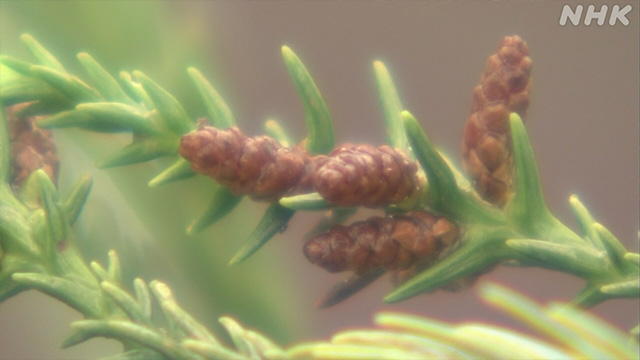A savior for hay fever?
What is “Elite Akita Cedar”? August 9, 16:40
The amount of pollen scattered is less than half.
Akita Prefecture has developed such a dreamlike cedar.
Its name is "elite Akita cedar".
When I looked into it, I found that I had passed through a narrow gate with a pass rate of only 0.06% until I reached the "elite".
(Akita Broadcasting Station Reporter Akihiro Kurokawa)
Cedar "elite"?
This is the sapling of "elite Akita cedar".
At first glance, it's hard to tell which one is "elite", but I compared it with regular Akita cedar.
Even though these two seedlings were planted at the same time and raised in the same way, the elite Akita cedar grows more than 1.5 times faster.
This shortens the time from tree planting to harvesting.
In addition, it is expected that the cost of cutting and shipping will be halved as the amount of undergrowth that is removed after planting trees will be reduced.
Also a “trump card” for decarbonization
Furthermore, due to its rapid growth, it is expected to be a "trump card" for decarbonization using forests.
We asked Mr. Hirofumi Sato of the Akita Prefectural Forestry Research and Training Center, who played a central role in the development.
Mr. Hirofumi Sato
“The amount of carbon dioxide absorbed by trees is proportional to the growth speed. Given the increasing importance of trees, we believe that they will contribute to carbon neutrality in the future.”
less than half of pollen
And there is another reason why they are "elite".
That's the hay fever countermeasure.
"Elite Akita cedar" is characterized by very few male flowers that emit pollen, so the amount of pollen scattered is less than half that of conventional trees.
It has the potential to greatly reduce cedar pollen, which is annoying for people with hay fever.
From “Candidate” to “Elite”
"Elite Akita cedar" is like a dream, but only a handful are certified as "elite".
Behind the scenes of development, a rigorous selection process was conducted.
The selection process started six years ago.
Akita Prefecture started by selecting cedars of superior size and quality from among 16,000 trees.
Only 47 were selected at this point.
They are, so to speak, "elite candidates".
The selection process will continue for another two years.
After turning the branches of the “elite candidates” into saplings, Mr. Sato and others strictly check the growth speed and the condition of the pollen-producing male flowers, and screen the “candidates”.
In the end, 10 were passed as "elite Akita cedar".
It is a narrow gate of 0.06% out of 16,000.
Mr. Hirofumi Sato:
“I visited 18 test forests in the prefecture many times and repeated the selection process. About three years after the start, I finally started to feel the results.When I was recognized as an 'elite', I really thought 'I did it.'
“Elite tree” countries also support
Trees with characteristics similar to "elite Akita cedar" are called "elite trees" and are supported by the government because they help realize a decarbonized society.
In the "Greenery Strategy" formulated in May last year, the government set a goal of making 30% of the seedlings for forestry use elite trees by 2030 and more than 90% by 2050.
Domestic paper manufacturers are also moving to produce "elite trees," which absorb more carbon dioxide from the atmosphere than standard varieties, in an effort to promote decarbonization.
Developing cultivars with “1/100” amount of pollen
In the future, Akita Prefecture will continue to verify whether the ``elite Akita cedar'' can grow smoothly even in the harsh winter of Akita, and after three years, we would like to start selling the seeds of the ``elite Akita cedar''. I'm doing it.
Mr. Hirofumi Sato
"Next, I would like to work on developing a 'low pollen cedar' that has 1/100 the amount of pollen scattered. We will develop a variety that will retain the originality of Akita for 50 or 100 years. I want to
Akita cedar occupies one-third of the total area of Akita Prefecture.
Replacing everything with "elite Akita cedar" would take a lot of time and money.
Will "elite Akita cedar" be a savior for people with hay fever after overcoming the challenges?
What is your contribution to “decarbonization”?
In addition, the global shortage of timber, also known as the “wood shock,” has raised the price of domestic timber, and the impact on the forestry industry is attracting attention.
Akita Broadcasting Station Reporter
Akihiro Kurokawa Joined
the station in
2009
After working at the Tsu station, the Okinawa station, and the political department from last year to the Akita station

